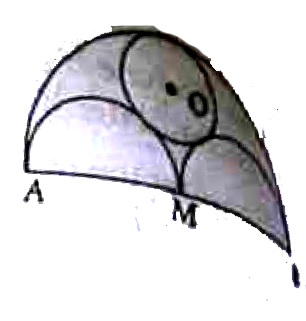In a triangle with sides, a,b, and c a semicircle toughing the sides AC and CB is inscribed whose diameter lies on AB. Then the radius of the semicricel is
a/2
Δ/s
2Δa+b
2abc(s)(a+b)cosA2cosB2cosC2
The correct Answer is:c
To find the radius of the semicircle inscribed in triangle ABC, we can follow these steps:
Step 1: Understand the Setup
We have a triangle ABC with sides:
- AC = b
- BC = a
- AB = c
A semicircle is inscribed such that its diameter lies on side AB, and it touches sides AC and BC.
Step 2: Area of Triangle
The area of triangle ABC can be expressed as the sum of the areas of triangles ACD and BCD.
Let the area of triangle ABC be denoted as Δ.
Step 3: Area of Triangles ACD and BCD
The area of triangle ACD can be calculated using the formula:
Area of ACD=12×AC×h1=12×b×R
where R is the radius of the semicircle and h1 is the height from point C to line AB.
Similarly, the area of triangle BCD can be calculated as:
Area of BCD=12×BC×h2=12×a×R
where h2 is the height from point C to line AB.
Step 4: Combine the Areas
Now, we can express the area of triangle ABC as:
Δ=Area of ACD+Area of BCD
Substituting the areas we calculated:
Δ=12×b×R+12×a×R
Factoring out the common terms:
Δ=12R(a+b)
Step 5: Solve for Radius R
Now, we can solve for the radius R:
Δ=12R(a+b)
Multiplying both sides by 2:
2Δ=R(a+b)
Now, divide both sides by (a+b):
R=2Δa+b
Conclusion
Thus, the radius of the semicircle is given by:
R=2Δa+b
We have a triangle ABC with sides:
- AC = b
- BC = a
- AB = c
The area of triangle ABC can be expressed as the sum of the areas of triangles ACD and BCD.
The area of triangle ACD can be calculated using the formula:
Area of ACD=12×AC×h1=12×b×R
where R is the radius of the semicircle and h1 is the height from point C to line AB.
Area of BCD=12×BC×h2=12×a×R
where h2 is the height from point C to line AB.
Now, we can express the area of triangle ABC as:
Δ=Area of ACD+Area of BCD
Substituting the areas we calculated:
Δ=12×b×R+12×a×R
Factoring out the common terms:
Δ=12R(a+b)
Now, we can solve for the radius R:
Δ=12R(a+b)
Multiplying both sides by 2:
2Δ=R(a+b)
Now, divide both sides by (a+b):
R=2Δa+b
Thus, the radius of the semicircle is given by:
R=2Δa+b
Topper's Solved these Questions
- MATHEMATICS BOOK - FIITJEECHAPTER - MATHEMATICS EXERCISE - PARAGRAPH BASED (MULTIPLE CHOICE)
34 Videos
- MATHEMATICS BOOK - FIITJEECHAPTER - MATHEMATICS EXERCISE - NUMERICAL BASED QUESTIONS
23 Videos
- MATHEMATICS BOOK - FIITJEECHAPTER - MATHEMATICS EXERCISE - ASSERTION REASONING
8 Videos
- MATHEMATICAL REASONING BOOK - FIITJEECHAPTER - MATHEMATICAL REASONING EXERCISE - ASSIGNMENT PROBLEMS (OBJECTIVE) LEVEL-2
18 Videos
- MATHEMATICS TIPSBOOK - FIITJEECHAPTER - MATHEMATICS TIPSEXERCISE - NUMERICAL DECIMAL BASED QUESTIONS
21 Videos
Similar Questions
Knowledge Check
AB is a line segment of length 48 cm and C is its mid-point. If three semicircles are drawn at AB, AC and CB using as diameters, then radius of the circle inscribed in the space enclosed by three semicircles is
A3√2B6C8D10In the given figure, M is the mid point of line segment AB whose length is 2a. Semicircles having diameters AM, MB and AB are drawn at the same side of the line. The radius of a circle toughing all the three semicircle is
 A2a3Ba2Ca3Da4
A2a3Ba2Ca3Da4
An equilateral triangle of side 6 cm is inscribed in a circle. Then radius of the circle is
View SolutionTwo circles are drawn with sides AB and AC of a triangle ABC as diameters
View SolutionA triangle has sides with lengths 13 cm, 14 cm and 15 cm. A circle whose centre lies on the longest side touches the other two sides. The radius of the circle is (in cm) 15 cm
View SolutionAn equilateral triangle of side 9 cm is inscribed in a circle. Find the radius of the circle.
View SolutionAn equilateral triangle of side 9 cm is inscribed in a circle. Find the radius of the circle.
View SolutionIn ABC, as semicircle is inscribed, which lies on the side ⋅ If x is the lengthof the angle bisector through angle C, then prove that the radius of the semicircle is xsin(C2).
View Solution
